In our last issue, we covered what we did over the summer: We saved an SE-R that was one step away from the junkyard and, with a few trick touches, made it a decent-to-drive car once again. Sporting a fresh, low-mile JDM engine, it was time to give Project SE-R a serious boost in power.
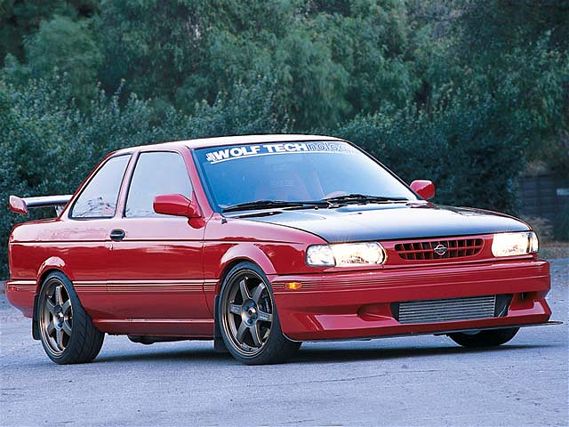 | SE-R Revisited- Part2
| SE-R Revisited- Part2 It's a little-known fact the Nissan SR20DE is one of the strongest, most boost-resistant engines available in the entire import camp. This is because the SR20 was originally designed from the ground up as a turbo engine, as it's offered with a turbo in the Silvia and Bluebird in Japan.
The block deck is closed, the crank and rods are beefy forged steel with thick bolts and the main caps are girdled from the Nissan factory. These specs give the SR20 the ability to hold boost in stock condition that would make a stock Honda engine roll over and play dead. In stock form, the SR can take 20 psi and more without a hiccup as long as detonation is kept in check.
To get Project SE-R boosting, we selected an F-Max Fabrication/Turbonetics turbo system. The F-Max turbo kit is, in the Nissan camp, reputedly the most powerful bolt-on system available for the SR20DE.
Since Project SE-R is intended to be a totally streetable car, our objectives for the turbo system were lofty. The car had to retain all of the stock power accessories. We weren't willing to give up air conditioning and power steering. We'd prefer to keep all of our emissions systems and it had to package cleanly in our engine bay without any major cutting and hacking.
Recently, F-Max teamed with the turbocharger powerhouse Turbonetics. This marriage will strengthen Turbonetic's position in the market because it can soon offer complete turnkey solutions to turbocharging many cars. Turbonetics' acquisition of F-Max allows it to offer high-quality turbo kits to go along with its core business, the manufacture of turbos, intercoolers, blow-off valves and wastegates.
The F-Max/Turbonetics manifold is log-style, made of TIG-welded, high nickel for heat-resistant cast steel. This material was chosen because of its temperature-resisting properties and its crack-abating, 0.125-inch thick walls. The thick wall tubing also helps contain exhaust heat, allowing the catalytic converter to stay lit, which is essential for keeping emissions at bay when running a cat.
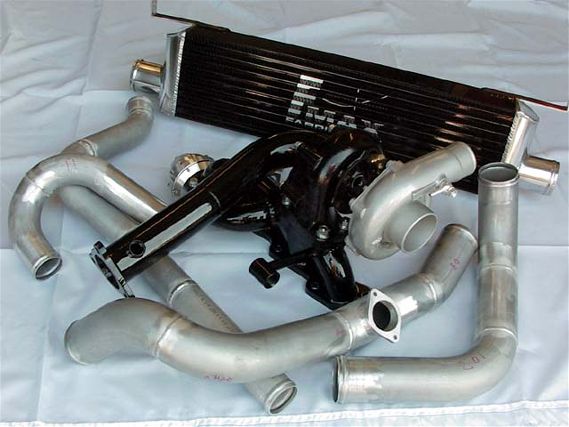 | Here is our Stage 1 F-Max/Turbonetics kit before we upgraded it to Stage 2 with a bigger TO4E/T31 hybrid turbo, thermo-barrier coatings and a larger, front-mount intercooler.
| Here is our Stage 1 F-Max/Turbonetics kit before we upgraded it to Stage 2 with a bigger TO4E/T31 hybrid turbo, thermo-barrier coatings and a larger, front-mount intercooler. Although a log manifold is not the ultimate for power production, it's a good choice for compact packaging, long life and fast spooling due to its short runner lengths and thick material. This makes a well-constructed log, and an excellent choice for a street manifold. We plan to prove the log can still make respectable, near-race power levels as well.
In our last installment, we didn't use the standard Turbonetics kit intercooler for our car. Although the Turbonetics kit already comes with a large, front-mount intercooler, we opted for the optional extra-large front mount that Turbonetics can make special order.
The Turbonetics intercooler uses a bar-and-plate style Spearco core. This core uses relatively thick, hollow aluminum plates with internal heat-conducting fins as opposed to the more common tube-with-external-fins type.
The Spearco core is superior because it has more internal surface area for better heat conduction as well as more mass. The extra mass is a plus in air-to-air intercoolers as the extra mass allows the intercooler to act like a heat sink, which then allows the intercooler to absorb heat at low vehicle speeds such as those seen off the line. Once air speed builds up, the intercooler can then begin to transfer built-up heat to the airstream.
A typical, tube-type lightweight intercooler only becomes effective once the vehicle's air speed rises. The core is the biggest that could fit in the front of the car without removing the air conditioner condenser, a huge 11 inches tall by 24 inches wide and 4.5 inches thick.
For a turbocharger, Tyler Tanaka of Turbonetics mated a Garrett T04E compressor wheel and housing to a lightweight, free-flowing T-31 turbine section. Tyler selected a 57 trim compressor for its ability to pump enough air to reach the low to mid 400-hp range.
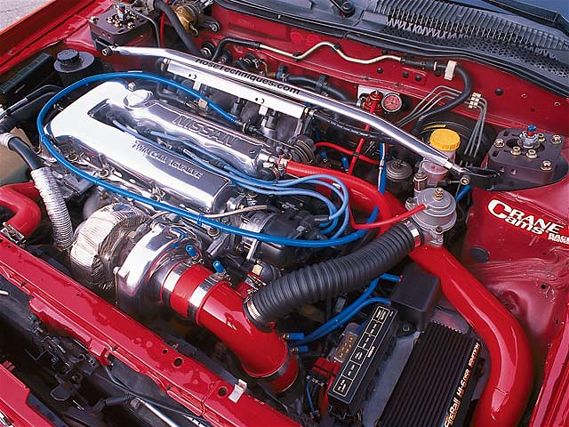 | No longer a junkyard relic, Project SE-Revisited is shaping up nicely. Our engine bay has evolved from the cobweb- and corrosion-filled mess it once was.
| No longer a junkyard relic, Project SE-Revisited is shaping up nicely. Our engine bay has evolved from the cobweb- and corrosion-filled mess it once was. A 0.50 A/R compressor housing was chosen to match the compressor wheel. Area ratio (A/R) is the way compressor housings and turbine housings are sized. The bigger the A/R numbers, the bigger the housing size. On the exhaust or turbine side of the turbo, typically a bigger A/R will produce better flow but induce more lag due in part to a lower internal gas velocity the bigger diameter creates.
It's kind of like spraying a pinwheel with water from a garden hose. If you put your thumb on the end of the hose to make a concentrated spray, that spray can make the pinwheel spin faster. At the same time, you are creating more backpressure inside of the hose, choking off its flow.
On the turbine side, the 76 trim T-31 is the largest commonly available turbine from Garrett's venerable T-3 family. It is a low-inertia design, also helping to reduce lag. Tyler selected a 0.82 A/R turbine housing as a good compromise between exhaust flow and lag for our street/track application. Turbos are especially sensitive to A/R on the exhaust side, so this was a critical choice in tailoring the engine's powerband.
Finally, the turbo used Turbonetics' exclusive ball-bearing center section. This center section uses a ceramic, angular-contact, cartridge-type ball bearing to handle thrust and rotational loads, as opposed to the traditional sleeve-type bearing most typical turbochargers use. The ball bearing center section has far less viscous drag than the old-school sleeve bearings and can handle more thrust load than the OEM thrust washer bearings used on off-the-shelf Garrett turbos.
Thrust-bearing wear is the Achilles heel of a performance turbocharger, causing most failures. The ball bearing can take up to 50 times more thrust load and usually has a minimum of three times longer life at high boost. The reduction in viscous drag and friction that the ball bearing center section creates can reduce turbo lag by 300 to 500 rpm.
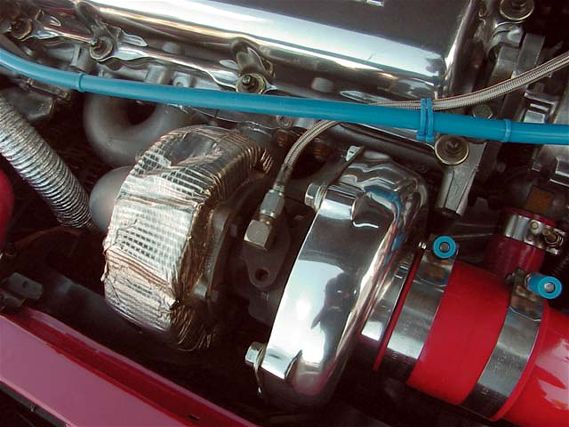 | A close-up of our bigger optional ball bearing center section turbo shows the tight fit of the larger-in-diameter TO4E compressor housing. Although our turbo is pretty big for street use, the short runner manifold and the ball bearing center section keep lag reasonable.
| A close-up of our bigger optional ball bearing center section turbo shows the tight fit of the larger-in-diameter TO4E compressor housing. Although our turbo is pretty big for street use, the short runner manifold and the ball bearing center section keep lag reasonable. To control boost level, a Turbonetics billet racegate external wastegate was used. To reduce lag between shifts and to prevent turbo shock wave damage, an HKS Racing compressor bypass valve was used. The Racing bypass valve has a much bigger control valve than the typical bypass or blow-off valve commonly available. It can dissipate the closed throttle shock wave quicker and stay open for a shorter period of time.
The bypass valve is plumbed back into the intake tract just before the throttle plate, so when the throttle is closed, boost pressure can be re-circulated through the compressor and back around and around until the throttle is opened again. By re-circulating the air, air metered by the Mass Air Flow meter (MAF) is retained in the system instead of being dumped outside the induction system like the typical blow-off valve. This prevents the engine from running too rich on overrun with a possible loss of driveabilty, a typical problem of the conventional blow-off valve.
Turbonetics constructed the 2.5-inch diameter downpipe out of crush-free mandrel-bent tubing. The attention to detail is superb. All junctions that are connected to the Hose Techniques silicon couplers are bead rolled for a positive seal. The intercooler pipes and the downpipe are clamped with Hose Techniques aerospace, quick release T- or Turbonetics' V-Band Clamps. All of the welding is TIG with precise beads reminiscent of those found on Indy and F1 cars.
To give the system a finished look, to improve catalytic converter light off and to prevent the hot turbocharger from cooking off plastic stuff in the engine compartment and our carbon hood, all of the tubing was coated with an optional polished ceramic thermal barrier finish. The coating and a Turbonetics insulated heatshield protects our carbon hood from melting due to the hot exhaust housing.
To ensure excellent air/fuel and ignition timing management, Turbonetics teamed with the master of Nissan ECU programming, Jim Wolf Technology (JWT). JWT supplied us with one of its ECUs tuned especially for a turbocharger and the stock SR20's 9.5:1 compression ratio--a compression ratio that's relatively high for a turbo engine.
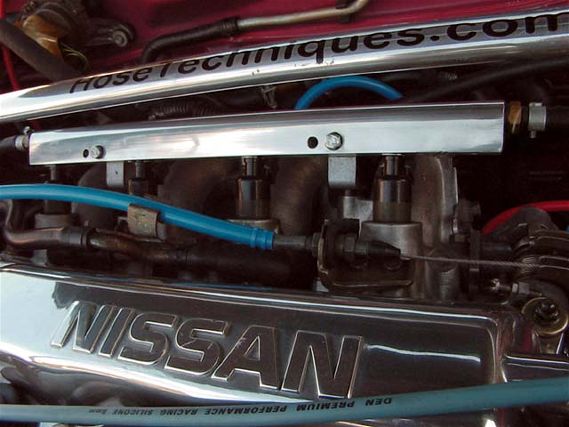 | Jim Wolf Technology's fuel rail converts the SR20 to cheaper top-feed injectors, which are available in a greater variety of sizes. We opted for 50 lb/hr injectors, which should provide enough fuel of a little more than 400 hp at 4 Bar of fuel pressure.
| Jim Wolf Technology's fuel rail converts the SR20 to cheaper top-feed injectors, which are available in a greater variety of sizes. We opted for 50 lb/hr injectors, which should provide enough fuel of a little more than 400 hp at 4 Bar of fuel pressure. We also opted for 50-pound top feed injectors, a custom fuel rail and a high-flow, big bore 70mm Cobra mass airflow meter from JWT. JWT has an off-the-shelf program for these components matched with the Turbonetics kit.
To ensure we would have sufficient fuel for the low 400-hp range if we needed it, JWT also programmed our setup for proper mixture with four Bar of fuel pressure, up from the stock three bar of pressure.
A large element JWT POP air filter strains the contaminants out of the turbo's airstream. An AEM billet fuel pressure regulator was used to control our fuel pressure via the fuel systems return line. To ensure we would have enough fuel under boost, we installed a drop-in, high-flow, 255-liters per hour Walburo fuel pump. The part number for the SE-R's kit is GCA3375-2.
Finally, we had all the parts, and with great care and trepidation, we installed the Turbonetics kit to Project SE-R. Actually, the installation was a snap, an easy bolt-on. The only tricky part of the install was drilling the oil drainback hole for the turbo in the side of the block.
Since the radiator was off the car and the front end of the car was disassembled for repair, it was much easier to access the front of the block so we could properly drill and tap the hole. If everything were in place, we would need a powerful right angle drill to do the job. Fortunately, this was the only really tricky part about installing the kit.
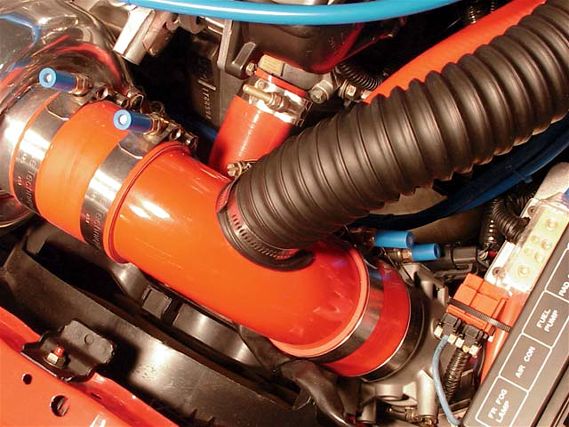 | The Ford Cobra MAF is located at the end of the compressor inlet pipe. A mass airflow meter from a big V8 Cobra Mustang ensures Project SE-R has enough air to breathe. It is at least twice the internal diameter as the tiny stock MAF. The Ford part is made by Hitachi, just like many of Nissan's OEM MAFs. To prevent swirl flow via the compressor from throwing off the MAF readings, the MAF should be located at least 14 inches from the turbo.
| The Ford Cobra MAF is located at the end of the compressor inlet pipe. A mass airflow meter from a big V8 Cobra Mustang ensures Project SE-R has enough air to breathe. It is at least twice the internal diameter as the tiny stock MAF. The Ford part is made by Hitachi, just like many of Nissan's OEM MAFs. To prevent swirl flow via the compressor from throwing off the MAF readings, the MAF should be located at least 14 inches from the turbo. For all of our complaining, it was a relatively painless process.
After installation of the kit, we fired up Project SE-R with the first few cranks. Thanks to JWT's programming, our car idled like a stocker and drove around smoothly, just like a factory-tuned car despite the large injectors. It was immediately apparent we had a lot of power on tap. On crappy California 91-octane pump gas, we could roll around pushing 10 psi of boost with no problems.
With a bottle of NOS race-octane booster in the tank, we were able to run an easy 14 psi of boost. Even at 10 psi, the car was a monster, easily spinning the fat BFG KDs in second gear from a roll. The owner of a built 1969 SS396 Camaro who cockily revved on us at a stoplight looked shocked and dismayed when our little junkyard refugee showed its taillights one evening.
In the next edition of Project SE-Revisited, we will add some additional peripherals so we can run more boost and try to push the limits of our stock engine and our off-the-shelf, bolt-on turbo kit. Get ready for some really impressive numbers.
Fuel Pressure Regulator
AEM
(310) 484-2322
www.aempower.com
Body Repair, Fabrication
After Hours Automotive
(714) 220-2030
Optima Battery
Johnson Controls, Inc.
Automotive Systems Group
(888)8-OPTIMA
(888) 867-8462
www.optimabatteries.com
Silicone Radiator Hose
Baker Racing
(800)959-7757
www.bakerprecision.com
G-Force KD tires
BFGoodrich Tires
www.bfgoodrichtires.com
Carbon hood scoop
Carbon Trix
(562) 906-5335
[email protected]
Tsuru Headlight Conversion Kit,
Genuine Nissan Parts, Nismo Parts,
Nissan Motorsports Parts
Courtesy Nissan
(800) 527-1909
www.courtesy-nissan.com
[email protected]
Carbon Hood, Rear Wing
Fiber Images
(661) 274-9500
www.fiberimages.com
Colored Silicone Hose, Stainless
Turbo Clamps
Hose Techniques
(310) 328-2800
www.hosetechniques.com
Structural Foam
ITW Foamseal
(248) 628-2587
www.itwfoamseal.com
ECU, Injectors, Cobra MAF
Conversion, POP Air Filter, HD
Clutch, Aluminum Flywheel
Jim Wolf Technology
(619) 442-0680
www.jimwolftechnology.com
TE37 Forged Superlight Wheels
Mackin Industries
(562) 946-6820
www.mackinindustries.com
Stainless Mufflers, Resonator,
Mandrel Bends and Hangers
Magnaflow
(949) 858-5900
www.magnaflow.com
Battery Relocation Kit
Moroso
(203) 453-6571
www.moroso.com
Tsuru Taillights, Nissan Genuine
Parts, Nismo Parts, Nissan
Motorsports Parts
Mossy Performance
Mossy Nissan Oceanside
(866) 55-MOSSY
(866) 556-6779
www.mossyperformance.com
[email protected]
Fabrication, Suspension and
Welding
Motivational Engineering
(562) 423-3616
www.motivational.net
Radiator, Nismo Parts
Nissan Motorsports
(310) 538-2610
Dyno Testing, Tuning
R&D Dyno Services
(310) 516-1003
www.rddyno.com
Used, Low-Mile JDM Engines
Soken Trade Corporation
(310) 324-7788
Seats, Pedals, Shift Knob,
Steering Wheel
Sparco Motor Sports, Inc.
800-224-RACE
www.sparcousa.com
Exhaust Fabrication and
Welding Work
Speedway Muffler
(310) 323-1322
Hi Flow Fuel Pump
TI Group Automotive Systems
www.tiautomotive.com
Aluminum Interior Panels
Toespeed Fabrication/Pro
Audio Motorsports
(310) 381-3610
Intercooler, Wastegate, Turbo
System
Turbonetics/F-Max Fabrication
(805) 581-0333
(760) 746-6638
www.turboneticsinc.com
www.f-max.com
Underdrive Crank Pulley
Unorthodox Racing, Inc
(631) 586-9525
www.unorthodoxracing.com
Walbro Aftermarket Engineering
(517)872-7347
[email protected]
Seat Adaptor
Wedge Engineering/ Seats Plus
(562) 633-1663
(800) 732-8771
Urethane Air Dam
Xenon
(800) 888-8753
(714) 632-1709
www.teamxenon.com
